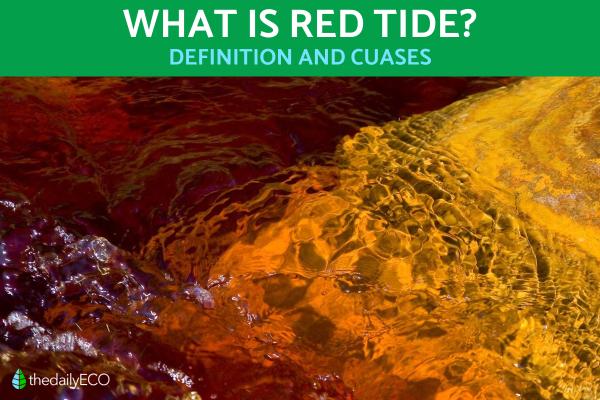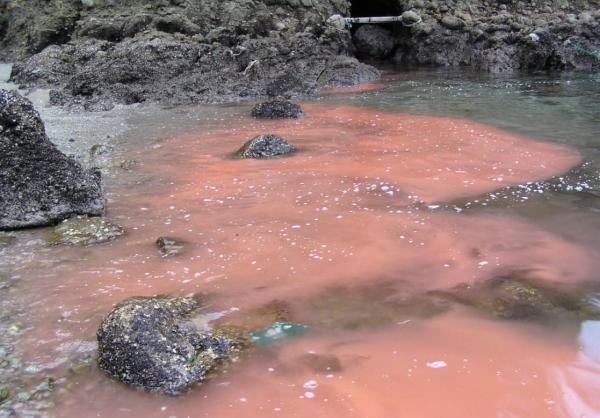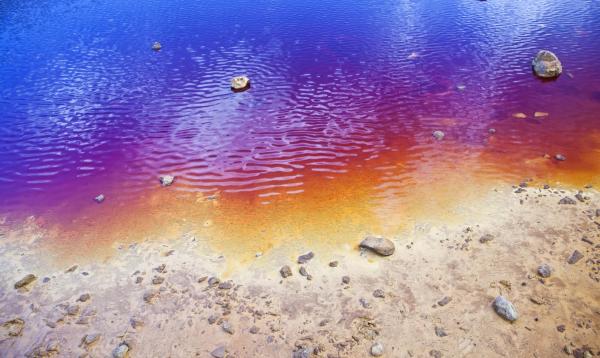
We take the color of various natural phenomena for granted. The sky is blue, the grass is green, etc. We know we can expect some variance in these colors. We don't think much of a gray sky on a rainy day, for example. When the difference is stark, it can seem like some sort of cataclysmic event. When the tide of a certain body of water turns red, it can be an eerie sight. A red tide is a natural phenomenon related to the proliferation of microscopic organisms in certain bodies of water. It might not mean the apocalypse is coming, but it can be a sign of problems within an ecosystem.
At thedailyECO, we ask what is red tide and what causes it? In answering these questions, we find out how they impact the ecosystems in which they occur and what this can mean for human populations.
What is red tide?
The red tide is a phenomenon of natural or anthropogenic origin produced by the rapid increase of microscopic algae. These are mainly in the form of diatoms, dinoflagellates and cyanobacteria. Along with other organisms, these constitute the phytoplankton on which a great diversity of species feed. Said microalgae may contain harmful biotoxins such as amnesic, paralytic and gastric toxins. These can harm the health of humans and other animals, even leading to death in some cases.
Red tides are so-called due to the natural pigments found in certain algae. While we may think of algae as being some shade of green, there are certain algae species which can be of various tones including purple, yellow and even red.
When a red tide occurs, a patch of different colored algae will move at different speeds according to the tides. In these cases, the algae can be easily observed. Not all microscopic algae are capable of staining water. There are occasions when this phenomenon cannot be observed with the naked eye. For this reason, the most appropriate name to refer to a red tide is harmful algal bloom (HAB), so-called whether or not the water is visibly red. It is also possible for harmful algae of different colorations to accumulate.
Another reason red tide is not always an appropriate terminology is because the tide does not always directly affect the bloom. Algal blooms can occur in coastal waters, but also in lakes, rivers and other bodies of water. Not all algal blooms will cause harm to an environment. For this reason, it has been suggested that benign forms are known as ‘algal blooms’ with malignant forms being known as HABs or ‘excessive algae growth’.
Learn some basics about these areas with our article on what are aquatic ecosystems?

What causes red tides?
For a red tide to occur, certain environmental conditions must be in place. These conditions allow the algae to reproduce differentially. The following conditions are conducive to a harmful algal bloom:
- Temperature increase
- Increased acidification (pH levels)
- Increased solar radiation
- Increased concentration of nutrients such as nitrogen and phosphorus
- Salinity from 15% to 23%
- Decrease in the agitation of aquatic systems due to light or absent winds with the subsequent stratification of the water
In the previous section, we stated there are two main origins of red tides. They are the following:
- Natural origin: the contribution of nutrients in a natural way. This may be due to a change in winds, since these produce changes in water currents that allow the outcrop of nutrients and consequently of the phytoplankton. It could also be due to contributions of rivers. For example, rivers such as those of glacial origin contribute a large amount of nutrients when they reach the oceans.
- Anthropic origin: organic contamination of bodies of water occurs due to various anthropic activities. These include urbanization, transport of nutrients by erosion (exacerbated by deforestation and agriculture), and the excessive use of fertilizers. All these actions cause an increase in the concentration of nutrients, mainly phosphorus and nitrogen. In turn this leads to a considerable increase in the intensity and frequency of algal blooms.
It is not only marine environments which can be harmed by human interference. Learn more with our article on the different types of ecosystems.
How long does a red tide last?
Many people wonder how long the red tide lasts. This may be out of scientific interest or practically speaking because we want to bathe in a particular area. Unfortunately, red tides do not have a specific duration. They can last only a few days, but can also persist for months at a time.
The duration period of a red tide will depend on various prevailing conditions. When the conditions are favorable to the microalgae and there are no climactic disturbances to remove the bloom, they will continue to reproduce and increase their population.
There has also been an increase in the amount and duration of harmful algal blooms in recent years. Algal blooms are mostly seen during the warmer parts of the year in freshwater ecosystems. Some studies correlate this to temperature increases as a result of climate change[1].
Learn more about the taxonomy of algae by looking at our article on what is the Protista Kingdom?

Consequences of red tides
Red tides generate disturbances in coastal environments. Not only can they harm human health, but they can be very detrimental to the flora and fauna of the ecosystems with which they interact. This can be seen in the aquatic animals which come in contact with a toxic algal bloom. Some of these species include mollusks, fish, reptiles, seabirds and marine mammals.
To know how these toxins harm and other animals, we can look at the different trophic levels of food webs. Phytoplankton are on the lowest level of the food web, using photosynthesis to sustain themselves. Red tide algae are a type of phytoplankton and larger animals will feed on them. As we go up trophic levels, larger animals will eat smaller ones, but many of them will already contain toxins from the harmful algae in their muscles and organs.
Around 80 species of algae are capable of producing these marine toxins that are concentrated in the edible portion of bivalve mollusks and in fish (although in lower concentrations). These organisms are consumed in great numbers by humans. If a person ingests a large number of bivalves or fish with a high concentration of toxins, it can cause poisoning. This is known as paralytic shellfish poisoning. If the condition worsens and is not treated, it can cause respiratory paralysis and even death.
Toxins cannot be removed even though shellfish are cooked at high temperatures as they are heat stable. In fact, when the presence of a red tide is identified, it is prohibited to extract bivalve mollusks, such as clams, oysters, scallops and mussels, since they are potentially dangerous.
Another way humans and animals can be harmed by red tides is by swimming in areas where an algal bloom has taken place. This is particularly common with dogs as they can jump into a body of water with abandon and won't think twice about drinking water. Some areas have also provided evidence of toxins from the red tide entering the air around the bloom and causing toxicity when inhaled[2].
Find out how we can help prevent environmental damage by looking at how to protect nature's ecosystems.
If you want to read similar articles to What Is Red Tide and What Causes It?, we recommend you visit our Facts about nature category.
1. Roberts, V. A., Vigar, M., Backer, L., Veytsel, G. E., Hilborn, E. D., Hamelin, E. I., Vanden Esschert, K. L., Lively, J. Y., Cope, J. R., Hlavsa, M. C., & Yoder, J. S. (2020). Surveillance for Harmful Algal Bloom Events and Associated Human and Animal Illnesses - One Health Harmful Algal Bloom System, United States, 2016-2018. MMWR. Morbidity and mortality weekly report, 69(50), 1889–1894. https://doi.org/10.15585/mmwr.mm6950a2
2. Wiśniewska, K. A., Śliwińska-Wilczewska, S., & Lewandowska, A. U. (2020). The first characterization of airborne cyanobacteria and microalgae in the Adriatic Sea region. PloS one, 15(9), e0238808. https://doi.org/10.1371/journal.pone.0238808
- Buschmann, A. (2005). Red tide and salmon farming in southern Chile. Retrieved from: https://www.ifop.cl/mr/images/upload/file/7_%20Marea%20Roja%20y%20Salmonicultura%20en%20el%20Sur%20de%20Chile_Buschmann%202005.pdf
- Red Tide: Foodborne Illnesses. Retrieved from: http://www.anmat.gov.ar/webanmat/Publicaciones/Marea_Roja.pdf
- Vivanco Font, E. (2022). Presence of red tide in Chile. Retrieved from: https://obtienearchivo.bcn.cl/obtienearchivo?id=repositorio/10221/33139/1/BCN_Presencia_de_marea_roja_Chile__2022_FINAL.pdf